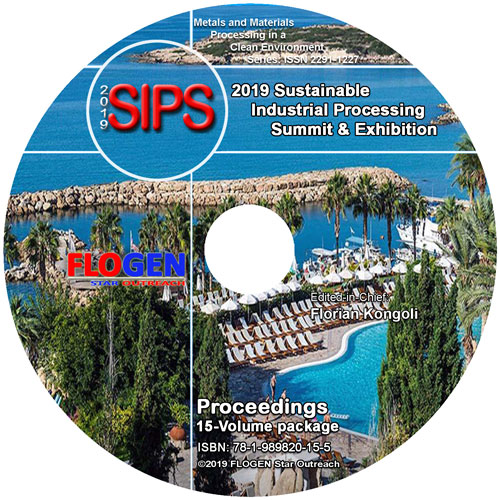2019-Sustainable Industrial Processing Summit
SIPS2019 Volume 8: Usui Intl. Symp. / Advanced Sustainable Iron and Steel Making
| Editors: | F. Kongoli, P. Assis, M.C. Gomez-Marroquin, S. Kitayama, H. Konishi, A. Murao, S. Nomura, H. Ono, H. Saxen, K. Seto, J.I. Tani |
| Publisher: | Flogen Star OUTREACH |
| Publication Year: | 2019 |
| Pages: | 250 pages |
| ISBN: | 978-1-989820-07-0 |
| ISSN: | 2291-1227 (Metals and Materials Processing in a Clean Environment Series) |

CD shopping page
In-Situ Evaluation for Crack Generation and Propagation Behavior of Iron Ore Burden during Low Temperature Reduction by Applying Acoustic Emission Method
Moritoshi Mizutani1; Tsunehisa Nishimura2; Takashi Orimoto1; Kenichi Higuchi1; Seiji Nomura1; Koji Saito3; Eiki Kasai4;1NIPPON STEEL CORP., Futtsu, Japan; 2NIPPON STEEL CORPO., Futtsu, Japan; 3NIPPON STEEL & SUMITOMO METALS CORP., Futtsu City, Japan; 4GRADUATE SCHOOL OF ENVIRONMENTAL STUDIES, TOHOKU UNIVERSITY, Sendai, Japan;
Type of Paper: Invited
Id Paper: 21
Topic: 2
Abstract:
Volumetric expansion during low temperature reduction of hematite to magnetite causes disintegration of iron ore burden in the upper part of blast furnace (1). The extent of such a property is generally evaluated by ISO11258/JISM8720 as a Reduction Disintegration Index (RDI) at low temperatures, where test samples are reduced with the constant gas composition at a constant temperature followed by the strength test after cooling. It is difficult, however, to observe detailed behaviors of crack formation during the test operation. Therefore, we have applied an acoustic emission (AE) method for an RDI test equipment (2). AE is an in-situ non-destructive technique that enables detection of the incidences of the generation and propagation of the crack (3)-(6).
In a single particle reduction, the sinter emitted a large number of AEs during cooling, and the AE energy of the sinter was higher than that of the pellet. Furthermore, lump ores containing high combined water emitted a large number of AEs during heating. The latter result implies that this method is useful for the evaluation the decrepitation of iron ore lumps.
In the packed bed tests, the effective AE signals were obtained against noise probably caused by frictions between the sample and the wave guide. The guide represents the average properties of the iron ore burden. The measurements revealed that thermal energy stress during cooling was higher than during reduction at 823 K for 30 min.
The results show that the value of the standard RDI is affected by the cooling operation, which is different from blast furnace conditions. The AE method will be applied as a unique measure to observe real disintegration behaviors of iron ore burden during reduction.
Keywords:
Blast; CO2; Furnace; Hydrogen; Iron; Process; Temperature;References:
1) T. Inazumi, K. Shinada and M. Kawabe: Tetsu-to-Hagana, 68(1982), 2207.2) M. Mizutani, T. Nishimura, T. Orimoto, K. Higuchi, S. Nomura, K. Saito and E. Kasai: ISIJ Int., 58(2018), 1413.
3) M. Enoki, S. Fujikawa and T. Kishi: Journal of the Japan Institue of Metals, 58(1994), 418.
4) M. Ohtsu: Research in Nondestructive Evaluation, 6(1995), 169.
5) K. Ito, H. Kuriki, M. Watanabe, S. Kuroda and M. Enoki: Materials Transactions, 53(2012), 671.
6) H. Nakamura: Journal of The Japanese Society for Non-Destructive Inspection, 62(2013), 267.